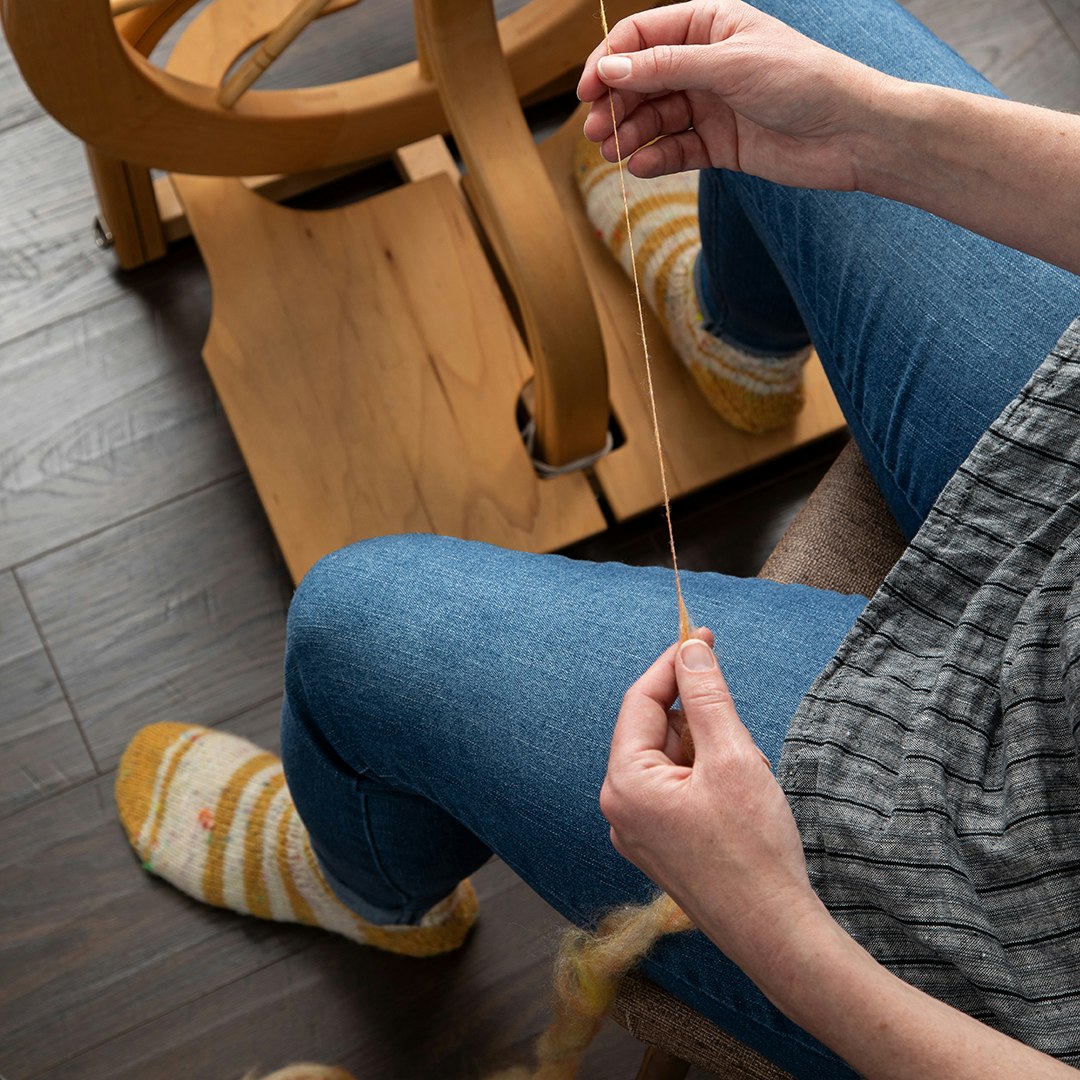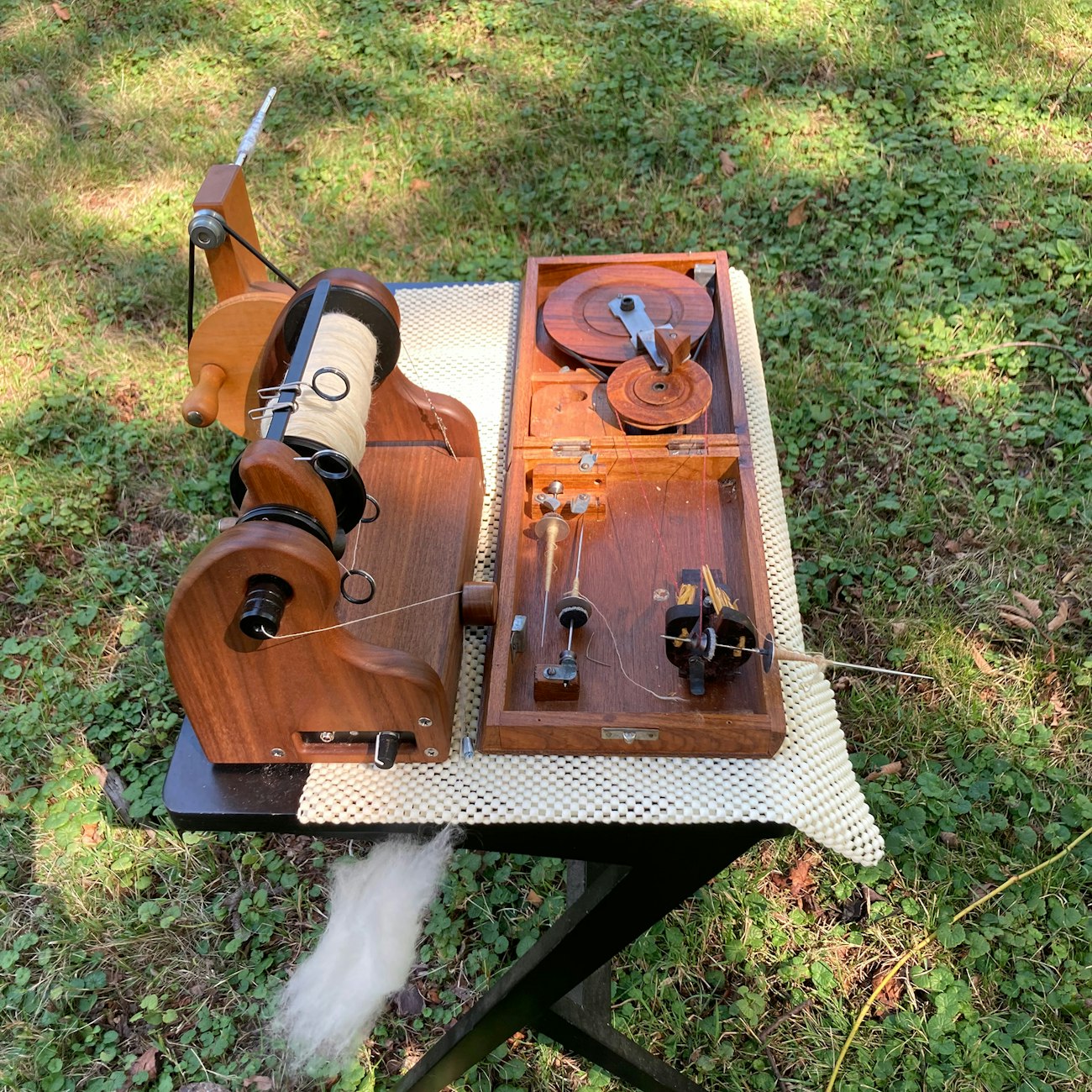In my 30 years of spinning, I have used and owned many spinning wheels. They have come and gone from my life for different reasons: economy, spinning style and skill, ergonomics, and aesthetics. This is fairly common among the spinners I know, and I think it is an important thing for newer spinners to understand. A spinning wheel purchase is not a lifetime commitment. Every type of wheel has a range of yarns it most effectively spins and spinners for whom they are the best fit. Each of the wheels I’ve owned has helped me learn more about what I like and moved my spinning skills forward.
The First Wheel
My first spinning wheel was an Ashford Traditional, a gift from my father when I was 10. I had been spinning with a spindle for a year and was eager to use a spinning wheel. This was my only spinning wheel for several years, and I taught myself to spin wool, mohair, and flax on this friendly wheel.
Next, I got an Ashford Elizabeth so that I could experience a double-drive wheel. Eventually, I sold the Elizabeth and found a used Louet S16 single treadle at a local fiber shop. I learned about bobbin-led wheels while spinning on the Louet, and I could use it to ply my spindle-spun singles.
The next step was finding a wheel with ratios that provided more speed. I had tried a Lendrum folding wheel once at a meetup and really enjoyed the double treadle and found the available ratios much more suited to the speed I preferred to spin. It came with the plying flyer, the standard, and the fast. The versatility sold me on it, and I bought it.
 Supported long draw on a Schacht Matchless. Spinners often discuss one versus two treadles, but treadle shape, movement, and location significantly impact your spinning joy. Learn more from Carson Demers in Spin Off Fall 2022. Photo by Matt Graves
Supported long draw on a Schacht Matchless. Spinners often discuss one versus two treadles, but treadle shape, movement, and location significantly impact your spinning joy. Learn more from Carson Demers in Spin Off Fall 2022. Photo by Matt Graves
More Wheels, More Options
After having only my Lendrum for several years, I found myself wanting to get a second wheel so I could have multiple projects going on at once. After a windfall, I was able to purchase a Schacht Matchless. I was drawn to its quiet running and versatility. At that point, I was spinning wool, bast, silk, and cotton, and I wanted a wheel that would work well with all of those very different fibers. The wide range of ratios and sensitive tension allowed me to spin long bast and short cotton fibers into the fine, high-twist yarns I prefer.
And the Others
Most spinners who have been creating handspun for a while often have other spinning wheels and equipment that have more specific applications or stories. I love the history of spinning and was able to purchase a great wheel (or walking wheel) at my local spinning guild. I used it a great deal during the first month or two of owning it. It took up a great deal of space in my studio, which also now included a loom. Later, I decided it was time to sell the wheel, knowing that I had enjoyed it for a time and that another spinner would enjoy it, too.
Many of my spinning friends had been using electric wheels for years by the time I finally tried one. At a spinning meetup, I needed to ply and didn’t have any empty bobbins. A friend let me use a HansenCrafts miniSpinner out of necessity. It was easy to use, and the speed at which I could ply was fantastic. I saved up and purchased my own Hansen. Soon I found it was a great complement to the spindles and various modern and antique wheels that I enjoyed using.
 Two additional spinning devices in Devin’s current spinning life: a HansenCrafts miniSpinner and traditional Indian charkha. Read more about Devin’s charkha journey here. Photo by Devin Helmen
Two additional spinning devices in Devin’s current spinning life: a HansenCrafts miniSpinner and traditional Indian charkha. Read more about Devin’s charkha journey here. Photo by Devin Helmen
Spinners rarely agree on the best kind of wheel because each spinner has different requirements for their tools. Everyone has a different style of spinning, different body sizes and shapes, different aesthetic needs, and all of these can change over time. A spinning wheel is a large investment, but I have found that I have always been able to sell a spinning wheel for what I paid for it (unless there was damage that occurred when I owned it). While it is a big commitment to purchase a wheel, it is not a lifetime commitment. When it comes to spinning wheels, I encourage you to follow your bliss.
Devin Helmen has been immersed in fiber since learning to spin at age 8. They spin, knit, and weave in beautiful Minnesota. Devin enjoys writing and teaching about fiber arts and has a passion for spindles and everyday textiles. They blog, intermittently, at afewgreenfigs.blogspot.com.

